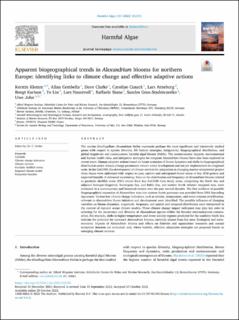| dc.description.abstract | The marine dinoflagellate Alexandrium Halim represents perhaps the most significant and intensively studied genus with respect to species diversity, life history strategies, toxigenicity, biogeographical distribution, and global magnitude and consequences harmful algal blooms (HABs). The socioeconomic impacts, environmental and human health risks, and mitigation strategies for toxigenic Alexandrium blooms have also been explored in recent years. Human adaptive actions based on future scenarios of bloom dynamics and shifts in biogeographical distribution under climate-change parameters remain under development and not yet implemented on a regional scale. In the CoCliME (Co-development of climate services for adaptation to changing marine ecosystems) project these issues were addressed with respect to past, current and anticipated future status of key HAB genera and expected benefits of enhanced monitoring. Data on the distribution and frequency of Alexandrium blooms related to paralytic shellfish toxin (PST) events from key CoCliME Case Study areas, comprising the North Sea and adjacent Kattegat-Skagerrak, Norwegian Sea, and Baltic Sea, and eastern North Atlantic marginal seas, were evaluated in a contemporary and historical context over the past several decades. The first evidence of possible biogeographical expansion of Alexandrium taxa into eastern Arctic gateways was provided from DNA barcoding signatures. Various key climate change indicators, such as salinity, temperature, and water-column stratification, relevant to Alexandrium bloom initiation and development were identified. The possible influence of changing variables on bloom dynamics, magnitude, frequency and spatial and temporal distribution were interpreted in the context of regional ocean climate models. These climate change impact indicators may play key roles in selecting for the occurrence and diversity of Alexandrium species within the broader microeukaryote communities. For example, shifts to higher temperature and lower salinity regimes predicted for the southern North Sea indicate the potential for increased Alexandrium blooms, currently absent from this area. Ecological and socioeconomic impacts of Alexandrium blooms and effects on fisheries and aquaculture resources and coastal ecosystem function are evaluated, and, where feasible, effective adaptation strategies are proposed herein as emerging climate services. | en_US |
